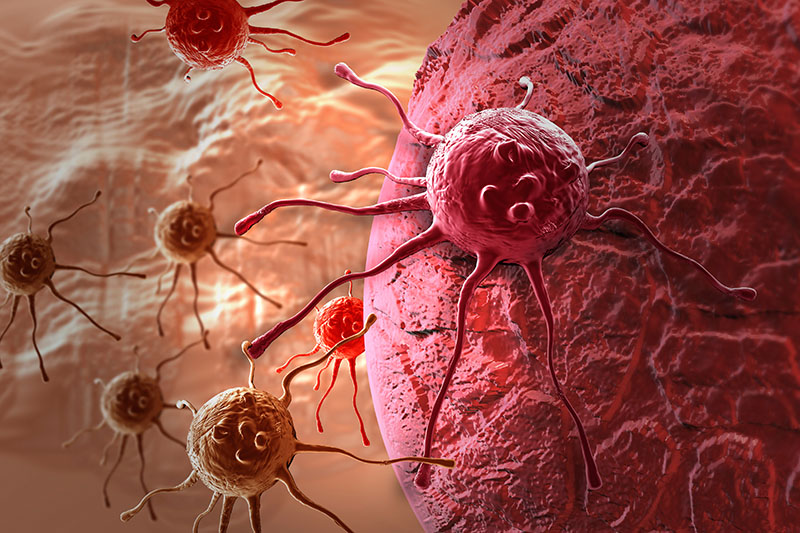Homing in on cancer
Whether a tumour develops from individual cancer cells and whether metastases are formed depends on many factors in the affected tissue. Researchers at the University of Zurich and at ETH Zurich have come up with an imaging method that is able to simultaneously visualize a previously unachieved number of factors involved in cancer.

Cancer is the second most common cause of death in Switzerland. There are many reasons why in the era of cutting-edge medicine it is still difficult to cure this disease. A tumour may, for instance, consist of different tumour cell subpopulations, each of which has its own profile and responds differently to therapy – or not. Furthermore, the cancer cells and the healthy cells in the body interact and communicate with one another. How a tumour then actually develops and whether metastases form depends on which signals a tumour cell receives from its environment. With the development of a new method the team around Prof. Bernd Bodenmiller from the Institute of Molecular Life Sciences at the University of Zurich in cooperation with the Trace Element and Micro Analysis Group of ETH Zurich and University Hospital Zurich has succeeded in comprehensively profiling and visualizing tumour cells from patient samples. This promising method has now been published in “Nature Methods”.
New imaging method – major opportunity
Setting out to determine a tumour’s cell profile, its neighbourhood relationships and the circuit structure within and in between cells is a highly complex endeavour. This is because the biomarkers, i.e. the specific molecules of the various cell types and their circuits, have to be measured in their spatial relationships. “With our method it is possible to obtain a comprehensive picture using a novel imaging technique that currently can simultaneously record 32, and in the near future more than one hundred biomarkers”, explains Bernd Bodenmiller, the study coordinator. Furthermore, thanks to state-of-the-art imaging the information about the cells’ neighbourhood relationships is kept and their direct impact on the cellular switch and control circuits can be visualised.
The new technique is based on methods which are already routinely used in hospitals – with two important innovations. First, the biomarkers are visualised using pure metal isotopes instead of dyes. To do so, biomarkers on very thin tissue sections are labelled with antibodies. The antibodies are coupled to the pure metal isotopes. Then tiny pieces of tissue are removed with a laser system developed by Prof. Detlef Günther from the ETH Zurich, and the metal isotopes of the pieces are measured with a mass spectrometer which can determine the mass and quantity of the individual metal isotopes. “This trick gets round the problem of the limited number of colours in the analysis of biological samples”, comments Bodenmiller.
Secondly, information about the cells, and their control circuits, is no longer qualitative. With the new measurement method it is possible to precisely determine which cells experience what effect and to which extent. In this way the weak points of the control system can be pinpointed and this helps in the development of new therapeutic approaches. This is the reason, so Bodenmiller, why it is becoming increasingly important to understand these interactions for diagnosis and therapy.
Customised treatment is the goal
The initial measurement results of the new biomarker technique for breast cancer have revealed the heterogeneity of tumours. As a consequence of major growth, some tumours suffer from oxygen deficiency on the inside, other misuse the body’s own immune cells to drive their growth. Cell-cell interaction and cell location in the centre or on the edges of the tumour also have a decisive influence. One thing is clear: no tumour is like any other and Bodenmiller believes that treatment should reflect this. In a next step his research team wishes to use the new measurement method to explore the roles played by control circuits and cell communication in metastasis formation.
This text was written by Media Relations of the University of Zurich and first published under external page www.mediadesk.uzh.ch.
Further reading
Giesen C, Wang HAO, Schapiro D, Zivanovic N, Jacobs A, Hattendorf B, Schüffler PJ, Grolimund D, Buhmann JM, Brandt S, Varga Z, Wild PJ, Günther D & Bodenmiller B. Highly multiplexed imaging of tumor tissues with subcellular resolution by mass cytometry. Nature Methods, published online 2nd March 2014. DOI: external page 10.1038/nmeth.2869
Comments
No comments yet